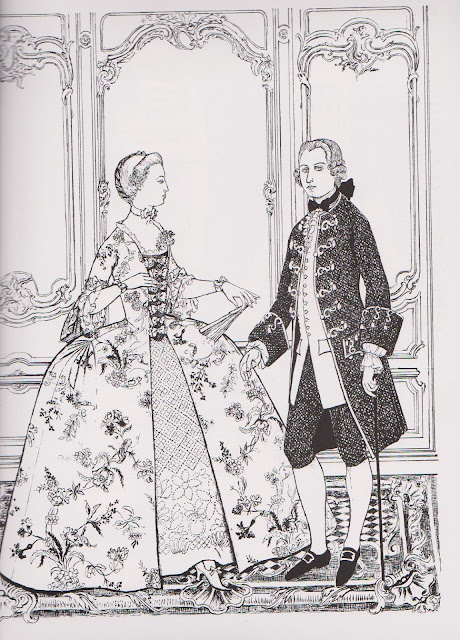Fabric: 100% silk taffeta, dark brown. Back lining is double layer cotton osnaburg. Front section lining is plain weave cotton and taffeta facings.
Construction: Hand stitched using period methods, including the "Weird running whip-stitch thingy" (this method has a French name, but darned if I can't remember it right now)
With back lacing fully closed
Chest: 40"
Waist: 36"
Note on Photos: I don't have a male display form, so I'm forced to improvise by using a small female dress form and then stuffing it with poly-fill, LOL. Not the best, but it's what I have at the moment.
The Pattern
To date I've made several garments from patterns in The Evolution of Fashion (search this blog for 'Margot Hill'), and so far I've been very pleased with the results. The patterns are basic, general in size and shape, and do require a pretty high level of historical sewing skill, as they come with no assembly instructions.
(above) This waistcoat is curved away at the front top and bottom, designed to be left open for the top 3 or 4 buttons. The sides and center back have vents open at the bottom to flare out.
Seams
I used a period accurate method I wasn't too familiar with before I started this garment. It's comprised of pressing under the seam allowance for the fashion fabric and the lining, then assembling the lining and fashion fabric of two section at the same time in one stitch. There's a link to a much better description of the method at the very top of this post.
The inside will end up looking like this (above) when you're finished.
The front lining is faced at the leading edge and the bottom skirt section. The fashion fabric is also interlined at the leading edge with twill, to provide extra support for the button holes.
Pockets
Quite simple, and made in the usual method. The flaps are not interlined, and are edge stitched.
The pocket opening is slightly triangle shaped to make it easier for the hand to get in.
FINISHED





















No comments:
Post a Comment